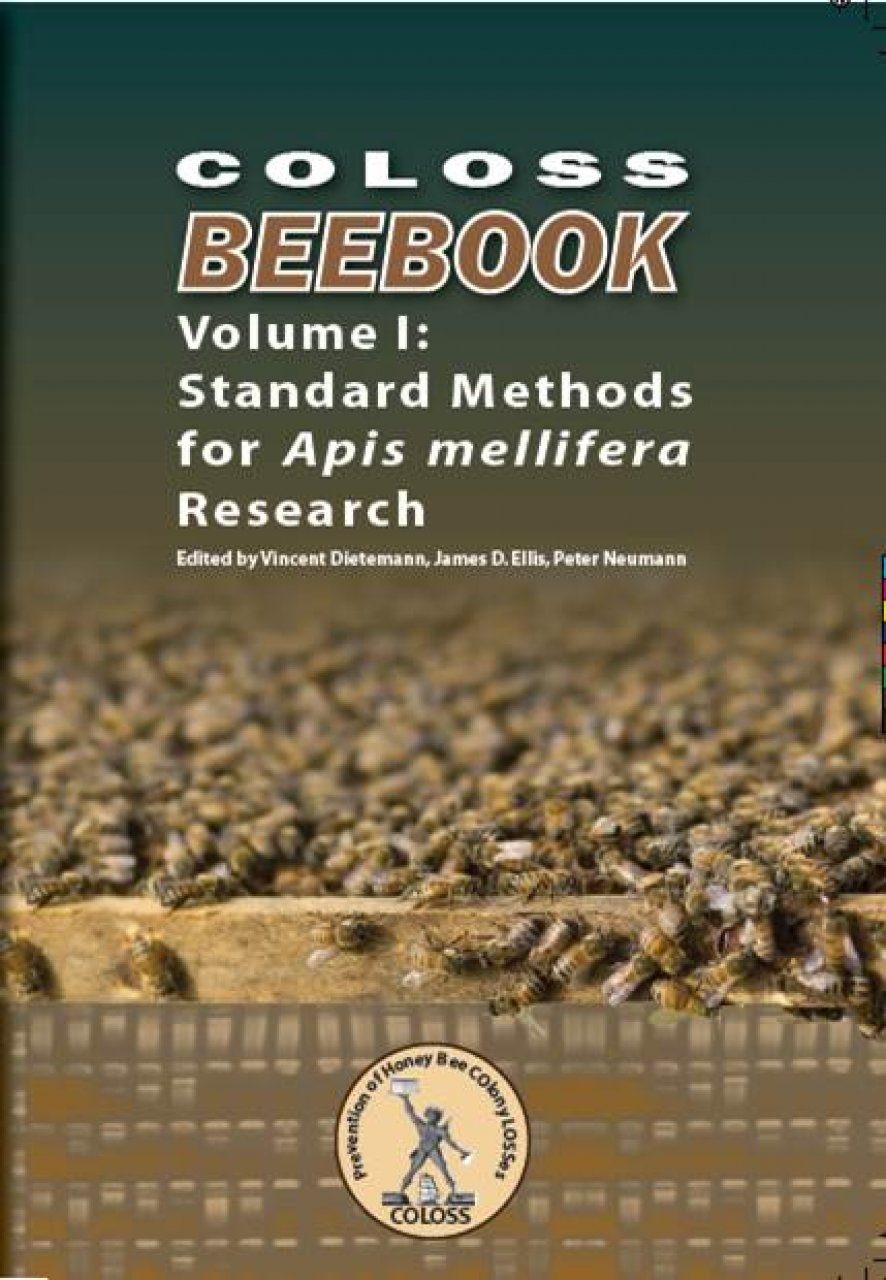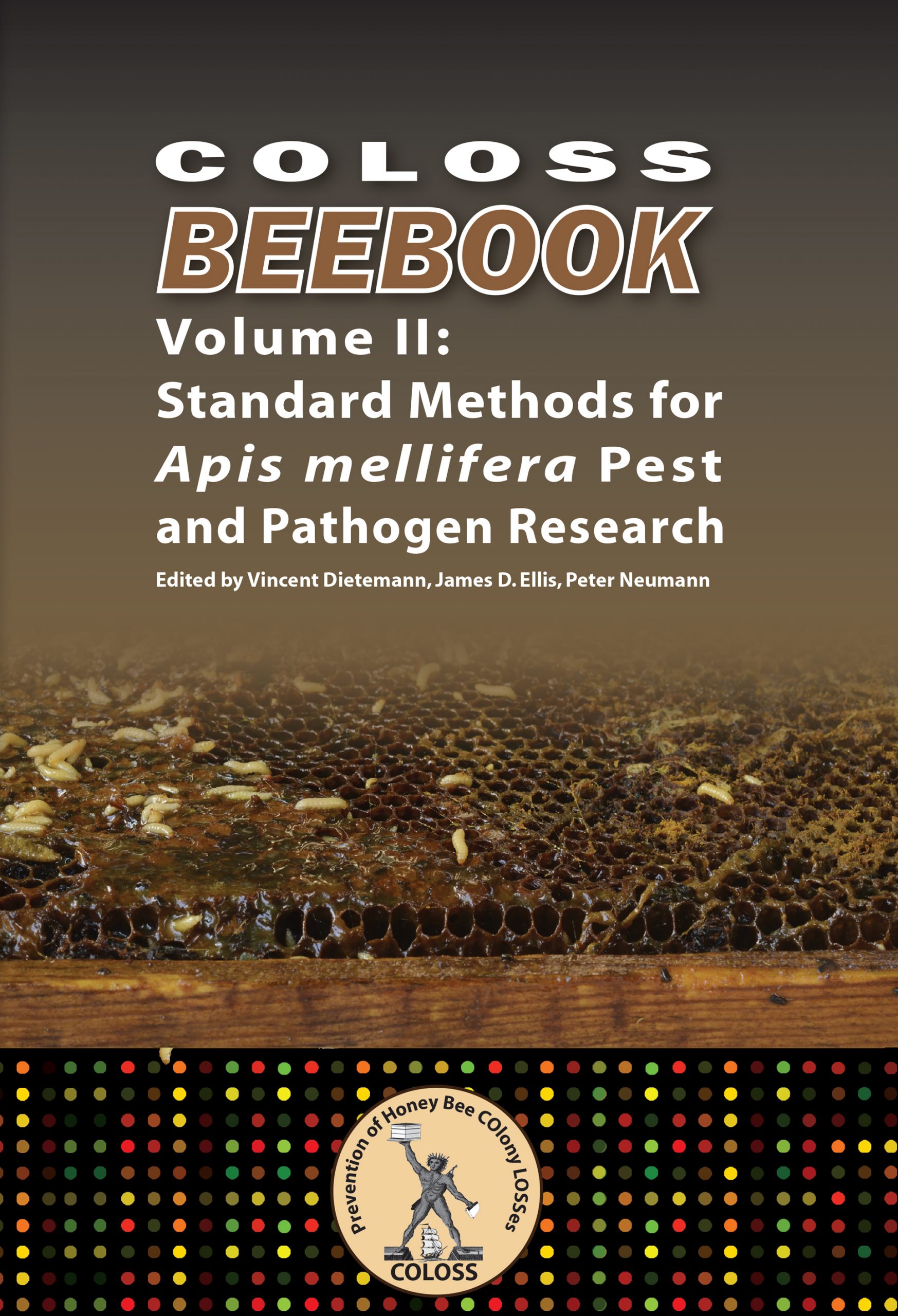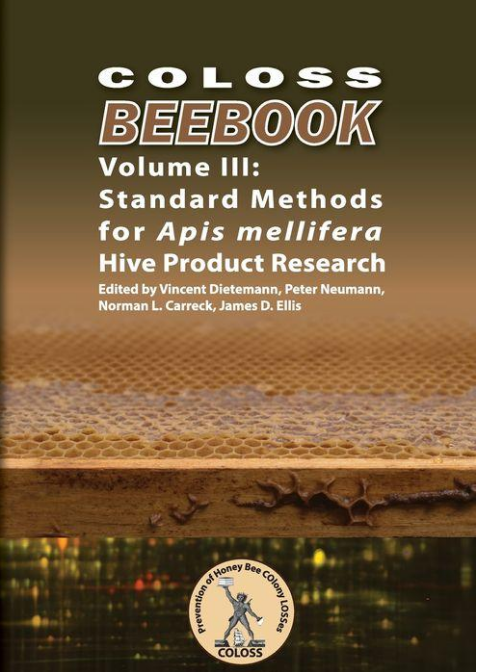Mark Winston
Let’s start by giving praise where praise is due: the three volumes of BEEBOOK: Standard Methods for Apis mellifera Research, published by COLOSS, are now complete, and the series is indeed a colossal achievement.
COLOSS is a consortium of 1815 researchers from 105 countries, with the collective mission of improving the well-being of bees, particularly the western honey bee Apis mellifera. The group’s logo specifically notes the “Prevention of Honey Bee COlony LOSSes,” which clarifies the name “COLOSS.”
BEEBOOK (they seem to really love CAPITALIZING) is a set of three extensive volumes that present standardized research methods to study honey bees. The first volume focused on methods to study honey bee biology, the second on methodology for pest and pathogen research, and the third, just published, deals with techniques to study products of the hive. Hardcover copies are available for purchase from the International Bee Research Association and Amazon, but all three books can be viewed online and downloaded at no cost.
The breadth and depth of these three volumes is breathtaking, with 350 researchers from 35 countries contributing to 38 chapters, each chapter with up to a dozen or more authors. And what a range of methods are covered: anatomy and dissection to chemical ecology research, protocols for maintaining worker bees in cages to methods of estimating colony losses, sampling regimes for pests to ways of rearing varroa mites for study, techniques to study hive products from royal jelly to pollen, and a whole lot more.
It’s an important series for the information it contains, and for what we can learn about the state of bee research today. BEEBOOK is first and foremost a compendium of research methods and strategies. It’s invaluable just for that, especially for young researchers, as a one-stop shop to dip into when designing a new research project. And, the series is designed to standardize how research questions are addressed, so that projects across the globe can be more easily compared.
BEEBOOK also reveals a robust research community, one that interacts and collaborates around the globe. A rich wealth of approaches emerges in each chapter, indicating a healthy diversity of perspectives, increasingly critical as honey bee health continues to decline.
For beekeepers, and even scientists, reading this series cover-to-cover would be a tough slog. The writing is dense and filled with jargon, as you’d expect from a necessarily technical publication. But it’s still worth a glance to get a sense of how research is done, and the abstracts in three languages that head each chapter provide a reasonably enlightening summary for those who don’t want to head into the weeds of methodological detail.
One of the more readable chapters, on how to measure colony strength, provides a good example of what these volumes contribute. The authors (Delaplane, van der Steen and Guzman-Novoa) first describe why a researcher might want to measure colony strength, either to produce uniform colonies at the start an experiment or to measure responses to manipulations. Then they describe objective methods that use some type of measuring device, subjective methods using visual estimates, and computer-assisted digitized analysis. They conclude by describing indirect measures such as flight activity and comb construction. Taken together, it’s a rich cornucopia of approaches for researchers to choose from as they design experiments for which colony strength is a good measure of the success or failure of colony management paradigms.
The immense variety and volume of research described in the hundreds of pages in these three volumes begs the question: with all this work, and so many approaches, over a time span of what’s now getting close to a couple of decades, why are honey bee colonies still dying all around the planet? In the United States, for example, annual colony loss hovers between 35-45%, compared to typical losses of 5-10% back when I started in with bees in the 1970’s.
If there’s a benefit to these precipitous colony death rates, it’s been in the rapid expansion of researchers and research funding to address this entomological and economic catastrophe. Research has certainly clarified why bees are dying, due to a synergistic mix of pesticide impact, nutritional deficiencies caused by lack of floral diversity and abundance, and a perfect storm of pests, parasites and diseases. Still, honey bees keep dying, and it’s fair to question whether research has done much to improve that situation.
Besides an increased understanding of why bees are dying, we’ve also learned a lot over the last 20 years about honey bees themselves, and the biology of the pests, parasites and diseases that afflict them. Research has led to some methods and some organic and synthetic pesticide tools with which to manage the biotic challenges faced by honey bee colonies, particularly varroa. Perhaps the best we can say, and it’s not a small thing, is that, due to research, at least things aren’t worse.
That’s a pretty low bar, though. My purpose here is not to fault the research community for its myriad contributions. Rather, I suggest that types of research not usually conducted, and thus not covered in the BEEBOOK, might be necessary if we’re to lower the rates of colony demise.
The lack of economic analysis in studies of honey bee colonies has always surprised me. The basic question begging for study is this: if you try Management Method X, be it a colony manipulation or a disease treatment, and add up all the costs and benefits of that management system, how much money will a beekeeper have in their pocket at the end of the season? Researchers sometimes go so far as to compare honey production, or colony survival, with different systems, but for commercial beekeepers those are indirect measures of what they really need to know: profit or loss at the end of the year.
For those interested in layering profit or loss into experiments, a good example can be found in Punnett, E.N. and M.L. Winston 1989. Comparison of package and nucleus production from honey bee colonies. Apidologie 20:465-472. In that study, we explored whether packages and/or nuclei could be produced in British Columbia, Canada in the spring, and determined the income from various combinations of package bee and nucleus production. The border with the United States had been closed in 1987 to package importations due to varroa, so our project was commercially important in exploring ways of providing beekeepers with a source of new colonies.
The least profitable system was the control, honey production alone ($50.51/colony, all figures in US 2021 dollars). The most profitable was producing two, two-pound packages and one four-frame nucleus ($106.55/colony) from each colony, followed closely by producing two nuclei per colony ($104.54). A beekeeper producing two packages and one nucleus would earn an annual income of $53,274 from an operation running 500 colonies. Note that those calculations are based on sale prices for packages and nucs in those days, and they sell for considerably more today, even correcting for inflation.
What is the best way to make a profit keeping bees today? Is it to run 10,000 colonies into California almonds each February, with all the associated costs and stressors on bees and beekeepers? Or, would stationary apiaries and an operation of 500 colonies, coupled with a value-added artisanal local honey marketing campaign, be easier on bees and their keepers, and leave you with as much or more money in your pocket at year-end? I often think of an Irish beekeeper I stayed with in County Mayo who has fewer than 200 colonies, and produces only 50-75 pounds of honey from each, but earns a terrific income because it’s heather honey and commands a premium price.
Besides a dearth of research that investigates management systems, there’s also a fundamental mindset missing in most applied honey bee research, which typically favors beekeeping rather than the bees. What if our research objective was to put the health and welfare of honey bees first, rather than conduct research through the lens of productivity?
There’s a growing movement with many names, called Darwinian, organic, treatment-free, natural or sustainable beekeeping, with the objective of keeping honey bees in a style closer to natural wild honey bee nests. These beekeepers espouse little or no management, small colonies, no swarm control, few or no chemical inputs, no supplemental feeding and low colony density in stationary apiaries. Commercial operators would agree that the way we manage bees for profit today is not “natural,” but they argue that the large colonies, swarm control, heavy chemical and feed inputs, apiaries with high colony numbers and moving colonies for pollination are what’s necessary to make a living.
But there’s been almost no research on if and how Darwinian beekeeping could become economic. There’s no question that hobbyists can be Darwinian, enjoy their bees and produce a bit of honey, but could commercial beekeepers whose livelihood depends on scale and profit manage colonies that way?
I led a research lab for almost 30 years, and stepped away from that to do other things (if you’re interested in where I disappeared to, visit the Morris J Wosk Centre for Dialogue), so no longer have the resources to study questions like this. Still, I’d like to throw out the challenge to today’s researchers, who are easily as good or better than my generation, to put together large-scale economic studies that discern the healthiest ways to keep bees that can also yield a decent income for the beekeeper. And there won’t be just one best way, but many different approaches. And my instinct, informed by those many years of studying bees, is whispering that there are profitable ways to manage colonies that aren’t as harsh on our honey bees as the current systems.
And here’s a request for the next edition of BEEBOOK: there’s got to be something better than losing close to half our colonies every year. A book that explores research methods focused on bee-first management paradigms for commercial beekeepers would be a welcome fourth volume of this already-stellar series.
Mark Winston is a Professor and Senior Fellow at Simon Fraser University’s Centre for Dialogue. His most recent books have won numerous awards, including a Governor General’s Literary Award for Bee Time: Lessons from the Hive, and an Independent Publisher’s Gold Medal for Listening to the Bees, co-authored with poet Renee Sarojini Saklikar.













